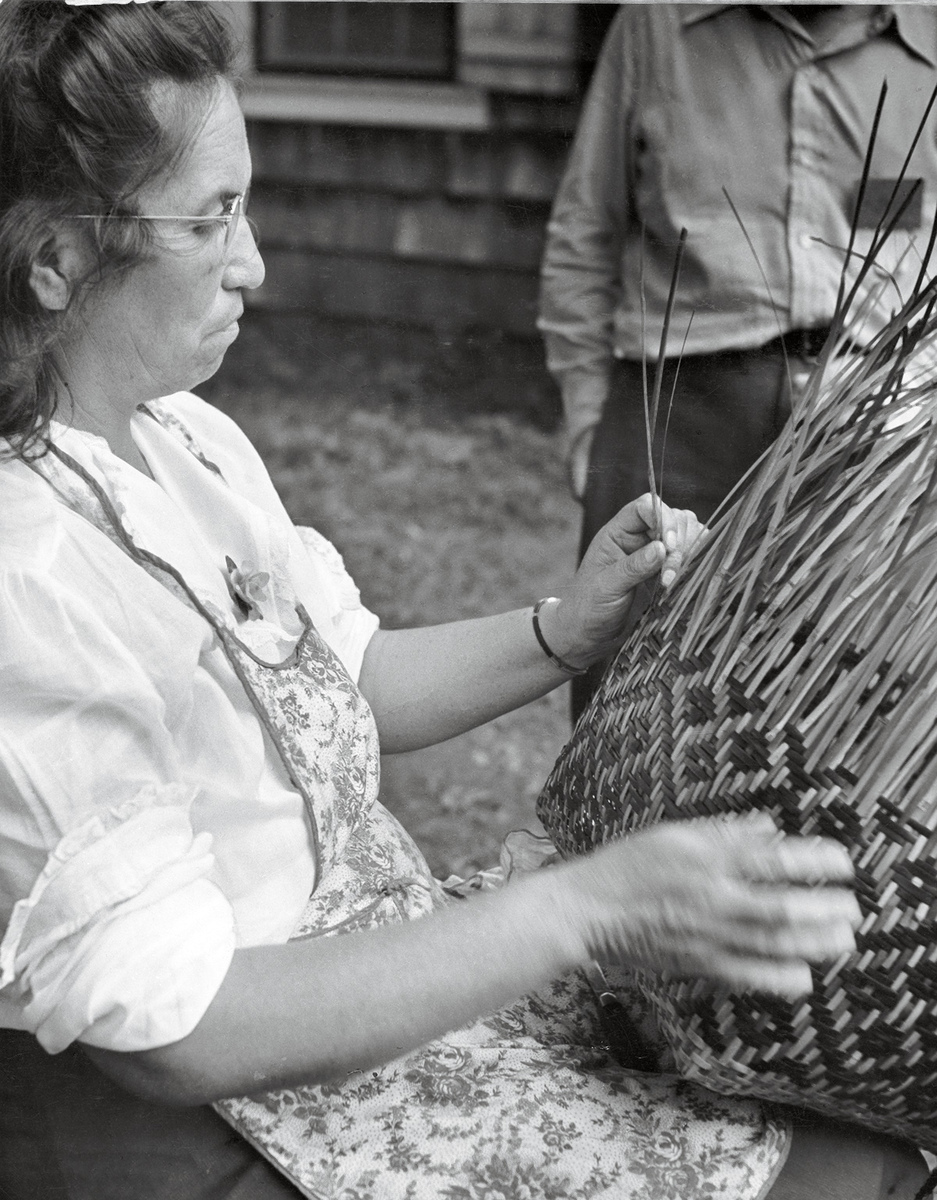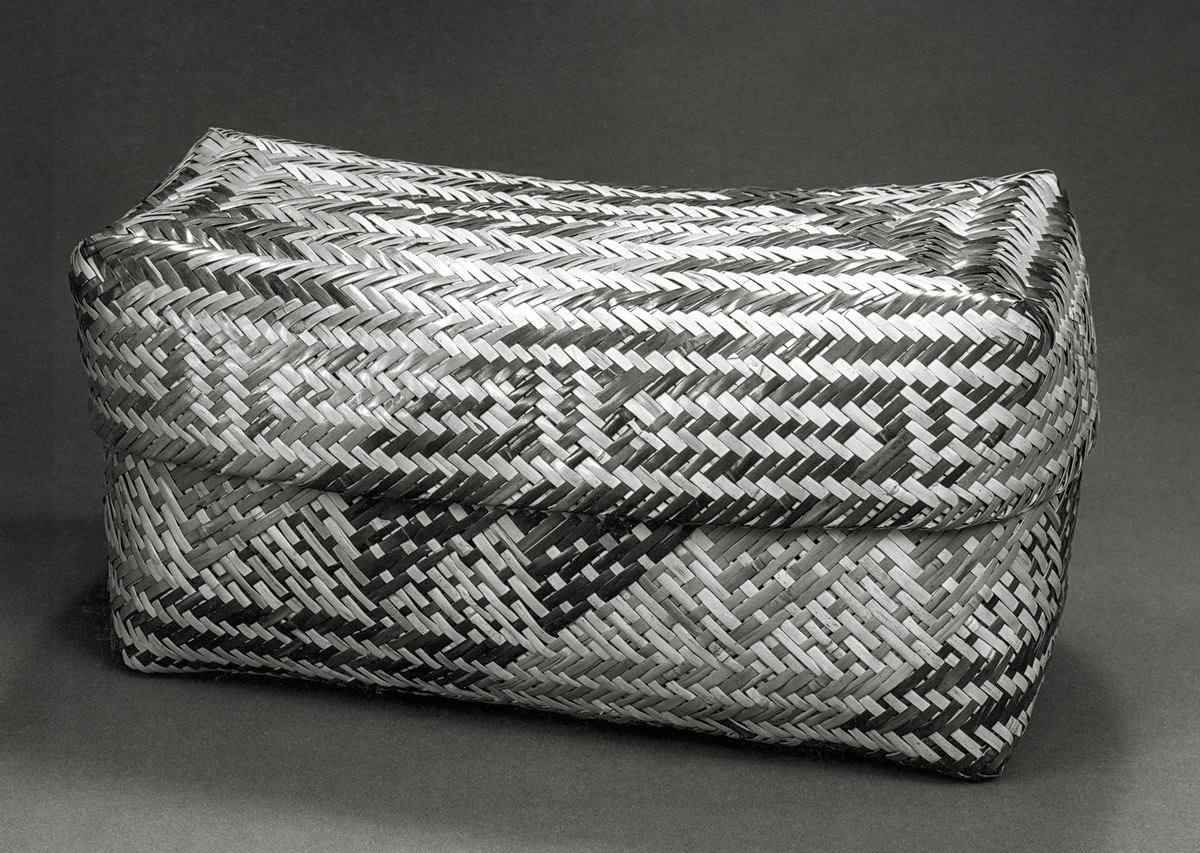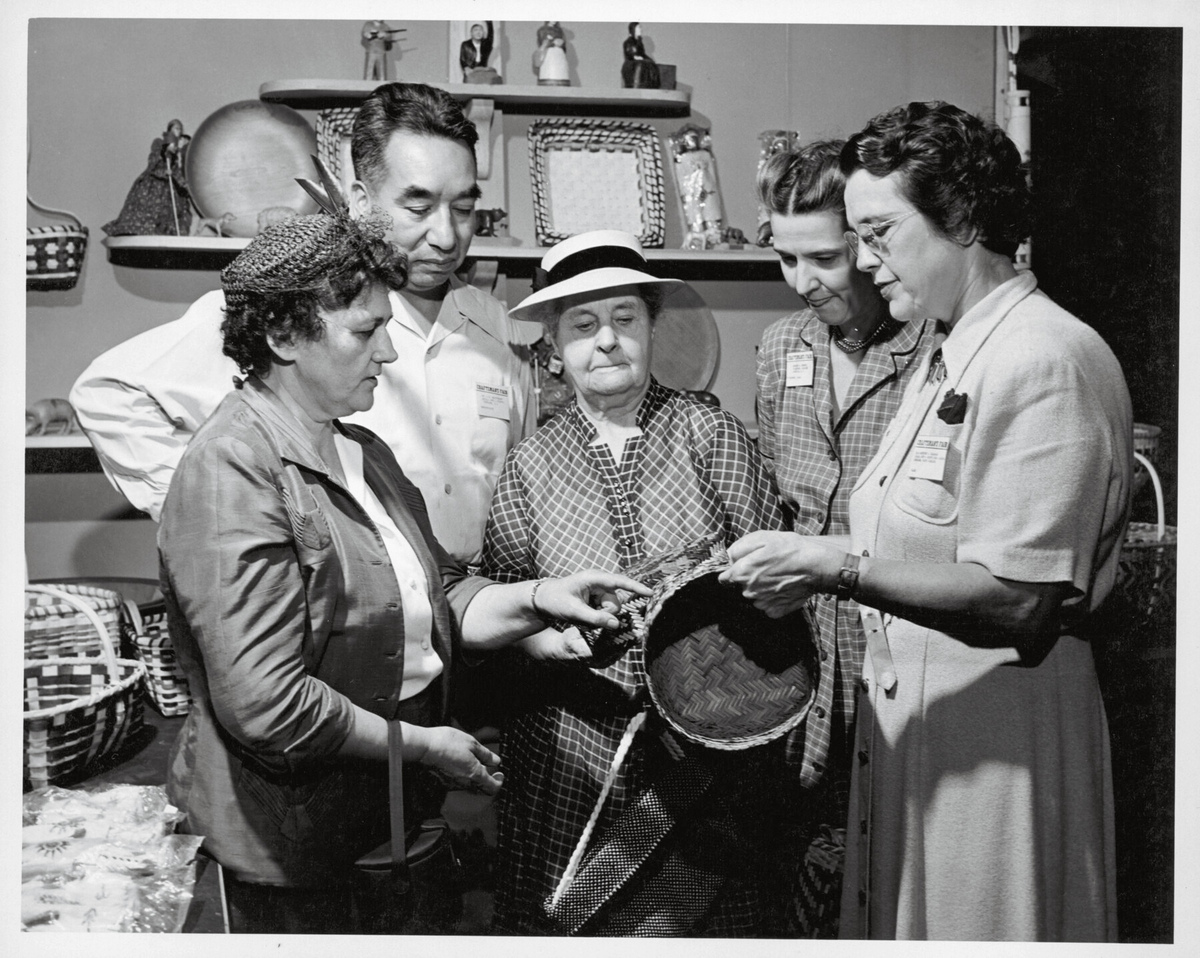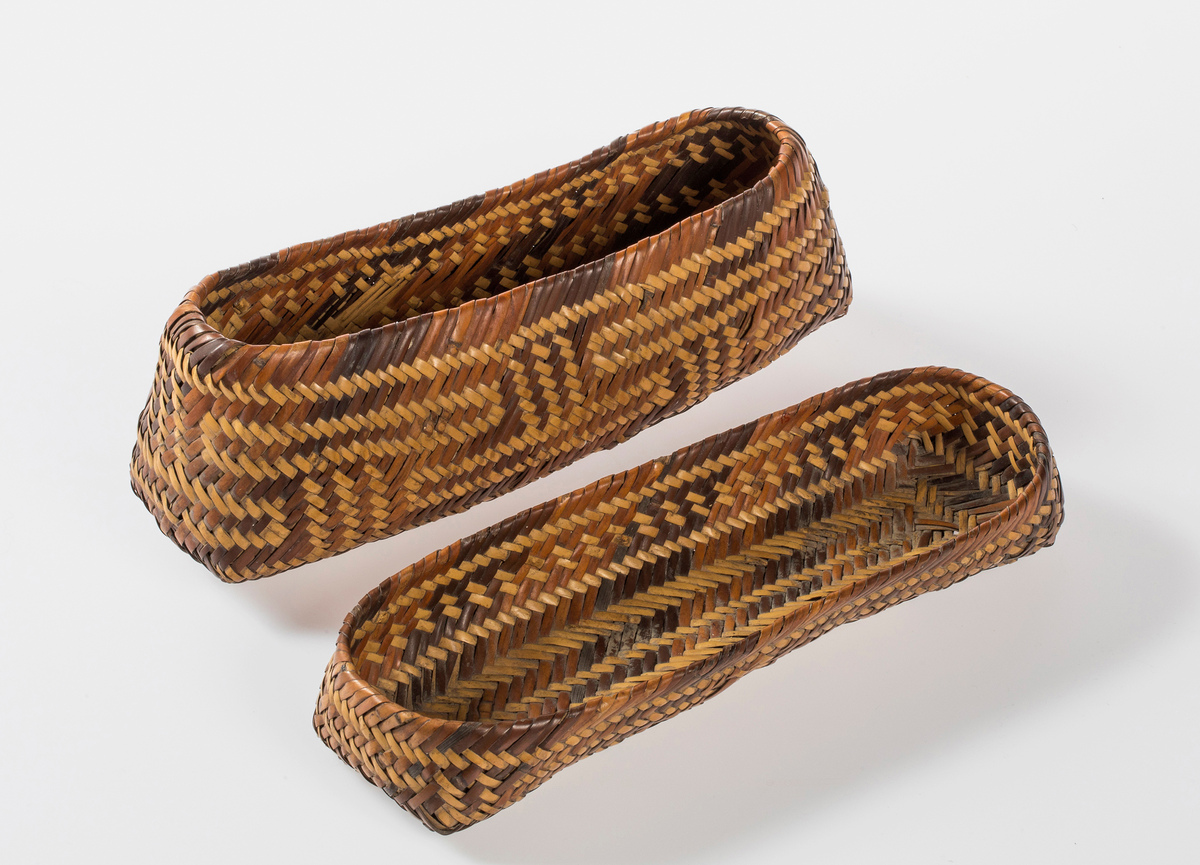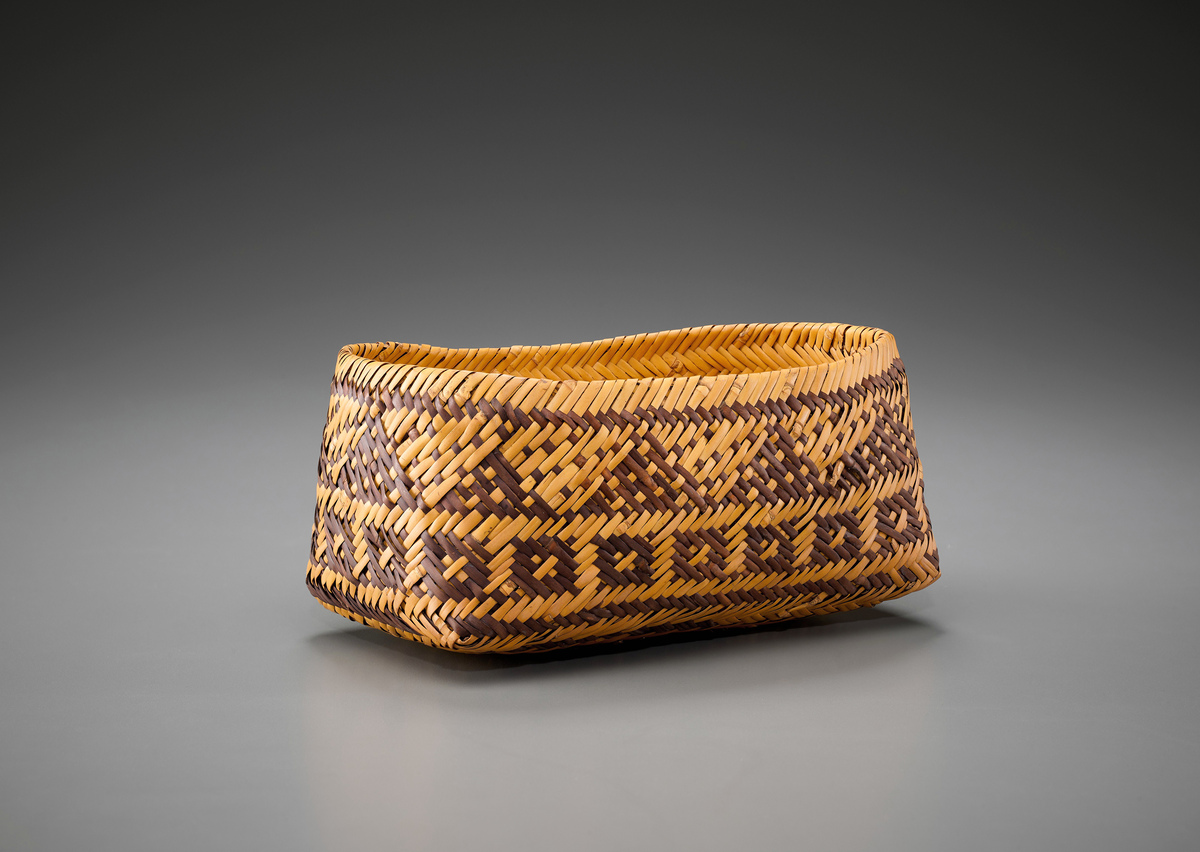Double Woven: A History of Cherokee Rivercane Basket Collecting, 1690–1947
The women are the chief, if not the only manufacturers, the men judge that if they performed that office it would exceedingly depreciate them. The weight of the oar lies on the women. 1
Multicolored, split rivercane baskets and basket weaving have long been synonymous with Cherokee craft traditions, particularly baskets produced for and sold to vacationing tourists during the twentieth century by members of the Eastern Band of Cherokee Indians (EBCI) on the Qualla Boundary in present-day western North Carolina.2 Rivercane basket weaving is not unique to the Cherokee, and similar basket-making techniques can be found in most southeastern Indigenous cultures.3 Among these rivercane baskets, the dyed and patterned double woven variety has always held the most significance to Native and European peoples because of the skill and time required to make them, their striking high-contrast patterns, and the double woven twill structure and material properties of the rivercane, which make the baskets watertight.
In 1940, Lottie Stamper (1906–1987), EBCI member and basket-making instructor at the Cherokee School in Cherokee, North Carolina, received “data on Houma baskets from Louisiana” and a photograph of a c. 1725 double woven rivercane basket in the British Museum from Helen Virginia Hunter, a graduate student in anthropology at the University of Pennsylvania (fig. 1).4
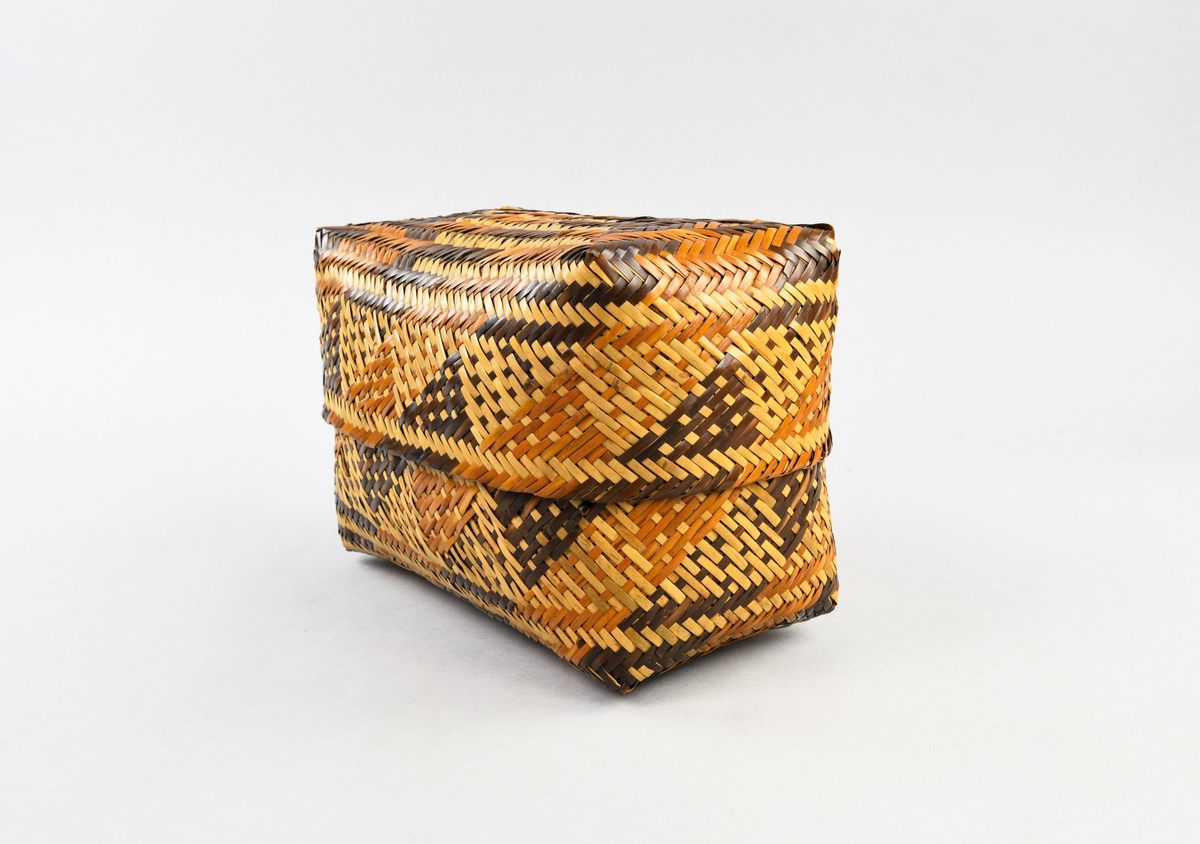
Figure 3 Lottie Stamper, basket with lid, Cherokee, North Carolina, 1946. Rivercane and pigments, 10 5⁄16 × 5 11⁄16 × 5 15⁄16 in. Penn Museum, Philadelphia, 46-6-49A/B
Stamper wove this basket and that in fig. 2 based on a photograph of an example in the British Museum collection (fig. 7). She identified the pattern on the base of both baskets as “Pineapple” or “Arrowhead.” Stamper inferred from the different size and pattern of the lid that the British Museum lidded basket was actually two baskets. A smaller tray-shaped basket had been mistaken for a lid. This basket was collected in 1946 by Frank G. Speck and John G. Witthoft on the “Cherokee Expedition” organized by the University of Pennsylvania.
Cherokee School principal Sam Gilliam and home economics teacher Gertrude Flanagan hired Lottie Stamper in 1937. From Mary Queen, her mother, Stamper learned to make oak-splint baskets, and from her mother-in-law how to process and work with rivercane, including the use of natural dyes. The Stamper family members became well-known producers of baskets for the growing tourist trade. Flanagan—a collector of Native craft goods, a Bureau of Indian Affairs administrator, and a craft revivalist—paid Stamper to approach Cherokee elder Rebecca Lon Toineeta about learning how to work in double weave (fig. 5).7 Toineeta would not agree to teach Stamper, but she reluctantly consented to critique examples of her finished work. Once Stamper achieved a satisfactory result, Toineeta told her not to return again.8
The cultural association between Cherokee identity and rivercane baskets is thousands of years old. Early European colonizers recognized the value of these objects for the Cherokee, and such connections endure today because of nearly one hundred years of mass tourism in southern Appalachia. Cherokee, North Carolina, sits at the southern entrance to the Great Smoky Mountains National Park—the United States’ most visited national park—where visitors from around the world arrive to learn about Cherokee culture and arts.9 Cherokee craftspeople have been juried members of the Southern Highland Craft Guild (founded in 1930) since 1932.10 The guild’s establishment was rooted in then-current assumptions that isolation, industrialization, and immigration had left the culture of white southern Appalachia untainted, and that its handicrafts were the last living vestiges of a premodern British America. Cherokee craftspeople, including Lottie Stamper, were involved in the guild’s administration to varying degrees, but Cherokee crafts and particularly the baskets served an important marketing role, giving further credibility to the guild’s claims of Appalachian authenticity (fig. 6). For the guild and other Appalachian heritage tourism organizations, Cherokee culture and craft lent an internal exoticism and legitimacy to the myths of Appalachia as a region frozen in the colonial era of American history.

Figure 5 Lon Toineeta (Lon Toyaneta/Lon Tooan-tuh), basket, Swain County or Jackson County, North Carolina, before 1908. Rivercane and pigments. National Museum of the American Indian, Smithsonian Institution, Washington, DC, NMAI_20147
The maker of this basket, Lon Toineeta, was the reluctant “teacher” of Stamper and one of the few Cherokee women still able to make double weave rivercane baskets at the beginning of the twentieth century. Lon’s basket is evidence of the continuation of double woven rivercane basket making after Removal in 1838 and through the nineteenth century.
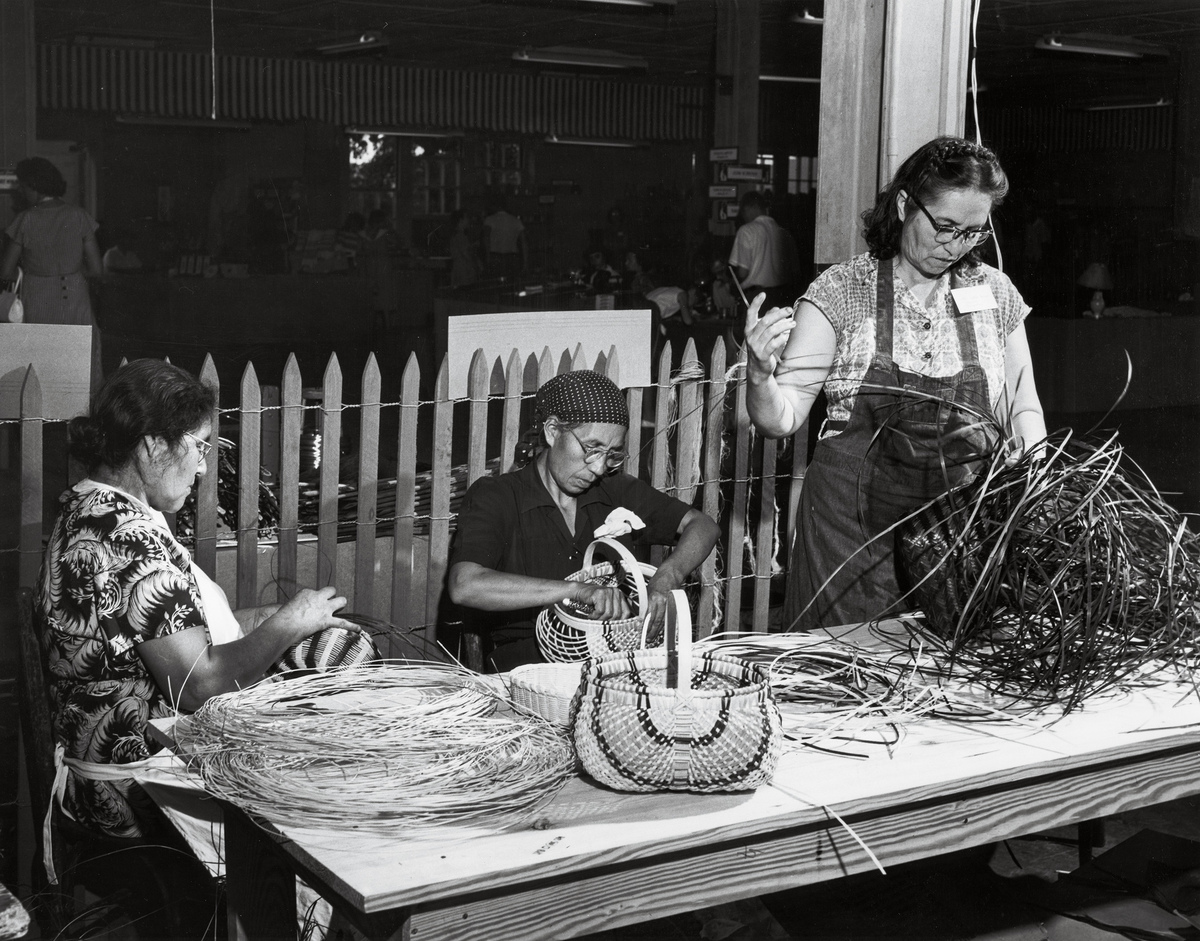
Figure 6 Cherokee basket demonstration at the 1952 Craftsman’s Fair, Pi Beta Phi Settlement School, Gatlinburg, Tennessee. Hunter Library, Western Carolina University, Cullowhee, SHCG_PhoCF6_6_82 (Photo: Edward L. Dupuy)
This photograph from the 1952 Southern Highland Handicraft Guild Craftsman’s Fair in Asheville, North Carolina, shows three EBCI basket weavers demonstrating with three different materials. Lucy George is on the left demonstrating weaving with honeysuckle over dyed wooden splints. Caroline Wolfe demonstrates making egg bottom baskets with hand-hewn white oak splints. On the right, Lottie Stamper is working with a nest of multicolored split rivercane splints to demonstrate the double woven basket-making process for visitors to the fair.
Congress passed the Indian Reorganization Act (IRA) in 1934. This is often referred to as the “Indian New Deal.” The Indian Arts and Crafts Board formed in 1935 as a result of the IRA to regulate craft sales, to protect and empower Indigenous makers, and to support the marketing of Native art and craft. Great Smoky Mountain National Park opened in 1940, directly connecting the EBCI to the park. In order to prepare for the surge in consumers and tourism, EBCI craftspeople formed the Qualla Arts and Crafts Mutual Inc. to regulate and market fine Cherokee crafts in 1946. Qualla Arts and Crafts joined the SHCG in 1949 and has been a member ever since.11 The story of Lottie Stamper’s study and reverse-engineering of a basket in the British Museum would become an important marketing tool for the cooperative (fig. 7).12 The story also represents the important history of the continuity of this craft and the centuries-long trade in these baskets.
By examining the economic and material history of the trade and collecting of these baskets, which can be traced back to the early eighteenth century, this essay seeks to better understand the historical relationships between double woven rivercane baskets, Cherokee identity and economy, and Euro-American collecting. Using extant objects and archival evidence, this essay will show the important socioeconomic and cultural role Cherokee double woven rivercane baskets played in sustaining the early years of the Cherokee trade in deerskins and enslaved Native peoples during the proprietary years of the South Carolina colony. As part of the secondary trade in Indigenous-made goods, two double woven rivercane baskets arrived in the private collections of important Enlightenment-age naturalists. Those baskets would eventually join the collections of the British Museum and the Museum of History at the University of Lund, Sweden. These are the only two eighteenth-century double weave rivercane baskets known to survive, and the discussion that follows will explore the history of their collection and context in terms of the South Carolina Cherokee trade, which was at its peak at the time of the acquisition of both objects in the 1720s.
Sir Hans Sloane (1660–1753) collected the better known of the baskets, now at the British Museum, along with 71,000 other objects throughout his life (see fig. 7). Sloane was a complex historical figure, and his legacy as both an Anglo-Irish Enlightenment scholar and a colonizer and enslaver is actively debated today. Although he never visited the continental British colonies, Sloane did serve for fifteen months in 1687–88 as personal physician to the Royal Governor of Jamaica, where he became fascinated with tropical plants and Afro-Caribbean medical traditions.13
Sloane’s reputation grew, and he served as both president of the Royal College of Physicians and president of the Royal Society. His preeminence in learned society connected him to a range of naturalists, both amateurs and emerging professionals, who were interested in learning about and categorizing the natural world as part of a program to commercialize and control it through empire. While such naturalists and their patrons collected Indigenous objects such as cane baskets as part of that imperial economic program, the narrative is complex and nuanced, and the economics of how these baskets traveled from the North American interior to the hands of Europe’s elite intellectuals has remained largely unrecognized.14
In his catalogue of “Miscellanea, Antiquities, Seals, Pictures, Mathematical Instruments, Agate Handles, Agate Cups, Bottles, Spoons,” compiled between c. 1692 and 1710, Sloane listed the basket as item number 1218 and described it as:
The next object in the catalogue is simply listed as “1219- A smaller one Id.” This entry almost certainly refers to the “lid” on the basket seen in figure 7, but it does not fit and has a different twill structure and pattern. This object was not intended to serve as a lid but rather is a smaller tray-like basket. As mentioned in the catalogue entry, Sloane acquired this item from Colonel Francis Nicholson.16 Sloane’s choice of phrase “whence he brought them” may indicate that Nicholson traveled with the baskets from Charleston when he returned to London in 1725 under corruption allegations; he died in 1728. It is possible that Sloane acquired both objects from Nicholson’s estate, but the manner and date of transfer is unclear from Sloane’s catalogue entry.17
In addition to these two Native cane baskets, Sloane received from Mark Catesby (1683–1749), a naturalist and agent of the Royal Society, several shipments of natural history specimens from the Americas. One of these shipments contained a cane basket collected from Virginia, now lost and known only as “object 1370” in the records. It was shipped with “object 1203,” described as an apron made of red mulberry bark.18 Sloane noted in his entry for the apron that “this kind of cloath wt. [with this] kind of basket they make wt. [with] splitt cane are the only mechanical arts worth notice Mr. Catesby.” Catesby is best known for his publications and beautifully illustrated plates of the birds and flora of the southern British colonies and the Bahamas. Royal Society members, including both Sloane and South Carolina Governor Nicholson, sponsored Catesby’s collecting expedition to the Carolina and Virginia colonies from 1722 to 1725.19
Catesby’s letters to Sloane during these travels shed light on the provenance of many items in Sloane’s collections and provide details on the logistics of collecting in the eighteenth century. From a letter dated November 27, 1724, we know that Catesby sent Sloane the now-lost cane basket and mulberry bark apron from Williamsburg, Virginia, aboard the Neptune.20 In a letter sent the previous November from Charleston, South Carolina, Catesby told Sloane of his exploratory plans for the following year, writing:
In this same letter, Catesby apologized for the disruption, delay, and partial destruction of his previous shipment of samples and objects as pirates had attacked the ship carrying them. Sloane died in 1753 and bequeathed his entire collection of objects to King George II in exchange for 20,000 pounds paid to his estate. Later that year Parliament passed the British Museum Act establishing the British Museum (as well as the British Library) as a national trust, making it the first national public museum.22
While the three rivercane baskets in Sloane’s collections were not the primary focus of his collecting activities, they are important material memories of an eighteenth-century transcultural craft economy. Before the cultivation of rice and indigo, the South Carolina economy was supported by the export of deerskins, the enslavement of Native peoples, and the trade in industrially produced goods to Indigenous markets. This mercantile cycle of extractive economic colonialism was at the heart of the British imperial model—designed to expand British territory, exploit its resources, and make its people consumer-subjects dependent on the metropole for goods and a marketplace.23 Trade goods, particularly weapons, were almost always of inferior material, quality, and design. Indigenous markets were economically dependent on the British industrial economy for the acquisition of these goods, in a relationship that reshaped local economies, societies, and cultures. In North America, these goods entered southeastern Native groups in the late seventeenth and early eighteenth centuries through the deerskin trade, but hides and furs were not the only lucrative commodity—enslaving other Indigenous groups became an important part of this trade in Carolina from the 1670s through the 1720s (fig. 8). Historians estimate that between thirty and fifty thousand Native peoples were enslaved and sold in Charleston during this period. At certain points in the colony’s early history, up to one-third of the people enslaved in the colony were Indigenous, but this number fell to two percent by 1730.24

Figure 8 Portrait of Lucy Parke Byrd (c. 1688–1716), 1716. Oil on canvas, 50 × 40 in. Courtesy of the Virginia Museum of History & Culture, 2018.41
This portrait of Lucy Parke Byrd, the first wife of William Byrd II, shows evidence of the early trade in Native goods and people. Byrd’s attendant is likely an enslaved Native boy. To her right is a polychrome Indigenous basket, its lid ajar, with an unidentified textile draped over the rim. William Byrd II, Charles City County planter, colonial lawyer, member of the House of Burgesses, and member of the Virginia Governor’s Council, was one of Mark Catesby’s first patrons, and Catesby likely would have met Lucy Parke Byrd on many occasions as his sister was a resident of Williamsburg, where the Byrds frequently resided.
Baskets or Mats of Split Reeds, which are exceedingly neat and handsome, being made only of the shining part of the Cane; with these I have seen Mats, Baskets, and Dressing Boxes, very artificially done.25
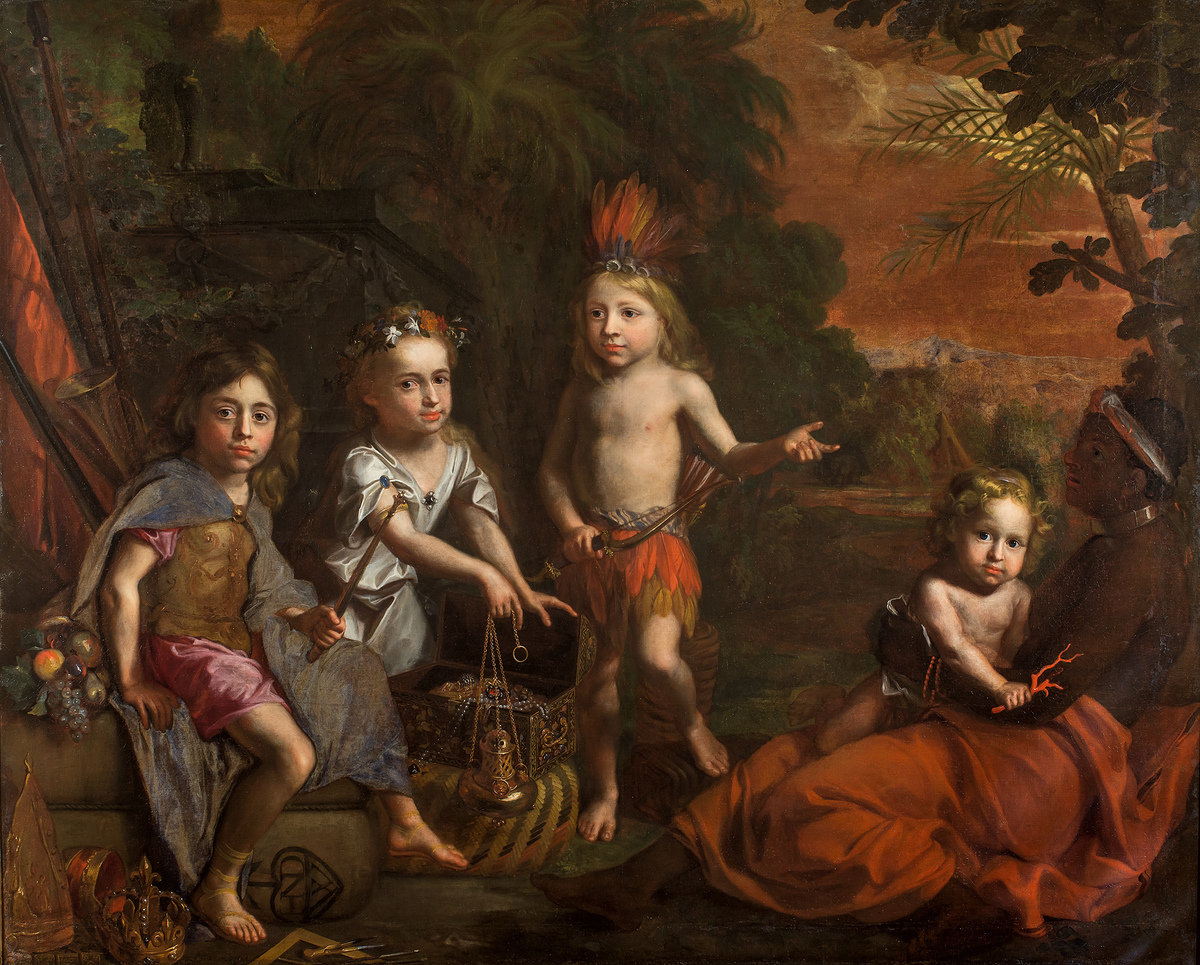
Figure 9 Gregor Brandmüller (Swiss, 1661–1690), Les trésors de l’Amérique / Les quatre parties du monde, 1682. Oil on canvas, 76 × 64 in. Musée du Nouveau Monde, La Rochelle, France, MNM.1980.4.2
This is the earliest depiction of a Native twill-woven basket, suggesting a French awareness of and participation in a basket trade likely tied to their pursuit of furs and skins in North America. The four children are allegorical representations of Asia, Europe, the Americas, and Africa, from left to right. Note that the African child is being held by a Black African wet-nurse.
Returning with a group of Palatine Germans, Lawson founded New Bern, North Carolina, in 1710. Enraged by the enslavement of Native people (particularly children), unfair trade practices, and colonists’ seizure of their land, Tuscarora warriors captured Lawson and the Baron of Bernberg. Lawson was ritually tortured and killed, signifying the Tuscarora’s recognition of Lawson as a warrior and leader; the baron was held captive for six weeks; and New Bern was burned. The Tuscarora War lasted until 1715 and saw the Tuscarora either killed, sold into slavery, or exiled to Haudenosaunee lands in present-day western New York state, where in 1714 they became the sixth member of the Iroquois Confederacy.27
A similar fate awaited the Yamasee people in South Carolina. Like the Tuscarora, they had close and early trading relationships with Carolina colonists, but land encroachments, Native enslavement, and unfair systems of credit and debit led to the Yamasee War (1715–17).28 The defeat and relocation of the Tuscarora and Yamasee saw the rise to preeminence of the Catawba Confederacy in the Piedmont and the Cherokee towns in southern Appalachia and an increased need for Indian Traders qualified to undertake the dangerous and expensive work of establishing military and trade relationships with North America’s Native peoples.29 Rivercane baskets and those entitled to the revenue from their sale played important roles in that economy.
These wars showed the failures of the proprietary government to regulate and control the colony’s trades. The crown had previously begun strengthening royal oversight of Carolina’s colonial administration, starting with the Board of Commissioners of the Indian Trade, which was created in 1707. Its nine members were almost without exception primary investors in the merchant firms charged with importing and exporting trade goods. These wealthy men were also the primary creditors to Indian Traders, whose jobs it was to organize, buy, transport, trade/exchange, and then return with goods bound for Britain. The traders, managed by officials known as factors, were licensed by the board, and due to the immense amount of capital required to enter the trade, many of these factors operated in extreme debt. The factors were extended credit in Charleston to pay for the guns, cloth, ammunition, rum, and other goods as well as the cost of transporting them to Indian towns upriver. Once they arrived in the Native communities, factors negotiated and extended their own lines of credit to Native hunters and leaders in exchange for the rights to trade and live within the community. Because this business was speculative and dependent on the abundance of game and access to hunting lands, cycles of extended debt and economic violence were commonplace.30
On November 1, 1716, Colonel Theophilus Hastings presented his accounts and journals to the South Carolina Board of Commissioners of the Indian Trade in Charleston, as was required of all licensed traders in the colony. While the details of those accounts are lost, a summary of them can be found in the meeting records of the commissioners of the Indian Trade.31 In his report, Hastings petitioned the Board of Trade for five assistants instead of the two initially assigned him that spring when the board appointed him as factor to the Cherokee. This appointment made Hastings the principle economic and political agent of the colonial South Carolina government among the Anglo-Carolinians’ newest Indigenous trading partners and military allies, the Cherokee.
Hastings also requested that the fixed prices on trade goods manufactured for the Indian Trade be lowered, “according to the Desire of the Indians”; however, it is possible that he intended to charge Cherokee customers the fixed price and collect the difference in an effort to recoup some of his losses. Hastings also asked for additional funds, on top of his salary of 300 pounds, to pay for the room and board of Native “burdeners” who helped ferry goods to and from the interior. It is unclear from the source material if those laborers were free or enslaved, Indigenous, or possibly a mixture of African, Native, and European laborers.32 Most curious was Hastings’s request “That Leave be given him to purchase a few Baskets, and such other small Things, to the Value of twenty Pounds per Annum, to make Presents of to his Friends.”33 Why was Hastings, a commissioned officer with a handsome salary, petitioning his employers for more staff, lower prices, and the right to sell baskets to recoup his expenses?
In fact, Hastings’s salary was not intended for his personal use or for him to accrue wealth, but rather to cover the expense of purchasing the trade goods needed to procure the next year’s deerskins. His petition was directly related to his attempts to limit his own overhead expenses and create opportunities to turn a profit while in the employ of another. Hastings’s request for the right to sell baskets to recoup the expenses of room and board for the Native “burdeners” he employed reveals the role played in this early colonial economy by Native manufactured goods such as cane baskets. Collecting and selling decorative rivercane baskets as curios, and even as utilitarian items, appears to have been so lucrative that Hastings petitioned for the right to engage in that trade.
On November 23, 1716, the board announced its decision. Hastings was permitted the five assistants, given an increase in his expense budget from 9 to 15 pounds, and allotted 20 pounds for the board of his employees when in the city. Interestingly, the board ruled “That all Baskets, to be bought by the said Hastings, be for and on the Account of the Publick, only.”34 The skins and other products of the Cherokee trade were offered at public auction “at or near the usual Place on Charles Town Bay.”35 The Board of Commissioners’ journal for January 23, 1716/17, noted that Hastings had received his shipment of trade goods and had sent “two Receipts for Skins and Baskets,” which had been received by the storekeeper in Savano Town (Savannah).36
In that same entry, the board heard a complaint from three Lower Cherokee warriors led by a man named Hootleboyau from “Tougeloe Town.” The Cherokee men accused John Jones, commander of the Edisto River garrison, of promising to pay them for skins and “painted Baskets.” Hootleboyau was reluctant to trade Jones three baskets for promise of payment later, but one of the unnamed Cherokee from “a Town called No-a-u-wee, let him have a ‘Basket, for which Jones promised him a Shirt, but cheated him likewise.’”37 Stories such as these reflect colonial power dynamics, but they also demonstrate the economic importance of rivercane baskets as well as their value as commodities. Jones’s willingness to swindle these men reflects the unregulated laissez-faire world of Early Modern capitalism in southeastern British North America.
Rice, indigo, and later cotton usually come to mind when thinking about the cash-crop commodities that helped establish colonial South Carolina’s bustling economy, but the deerskin trade and the subsequent trade of Native goods including baskets became an important, albeit intermediary, part of the global trade that linked Cherokee towns to the growing British Empire.38 Moving Indian Trade goods (guns, ammunition, metal tools, and textiles) manufactured in industrializing colonial metropoles specifically for Native communities located inland and upriver, and exchanging them for deerskins, furs, and other products deemed valuable, was at the heart of Hastings’s job as a Cherokee factor. Rivercane baskets were among the Native goods bought and sold in colonial marketplaces, and there is evidence from the earliest days of this trade that Native people, colonial traders, and naturalists all engaged in the trade and collecting of these baskets. The examples at the British Museum and the Museum of History at the University of Lund likely owe their survival to their association with Enlightenment patterns of collecting.
The history of the collection of the eighteenth-century double woven rivercane basket at the University of Lund’s Museum of History can be traced to Samuel Hesselius (1692–1753), brother of the famed SwedishAmerican painter Gustavus Hesselius. From 1712 to 1731, Samuel lived with his brother in the Delaware River Valley, where he worked as a Lutheran pastor before returning to Sweden. While in North America, Samuel traveled throughout the Middle Colonies, and he amassed a collection of Native artifacts. The lidded double woven rivercane basket was among those objects and listed by Hesselius as artificalia, a term describing objects within a cabinet of curiosity that demonstrate great human ingenuity and craft (figs. 10, 11).39 He catalogued his collections in 1736, recording what he knew of each object, and sent all of the objects to a family member, Count Carl Gyllenborg, who was lecturing at Lund University, with the understanding that they would be gifted to Uppsala University, Hesselius’s alma mater. Instead, Gyllenborg donated the objects to the newly formed Museum Stobaenum, a natural history museum built from the collections of Kilian Stobeaus (1690–1742), Swedish physician and tutor of Carl Linneaus. Until recently, it was presumed that the Hesselius assemblage was lost.40
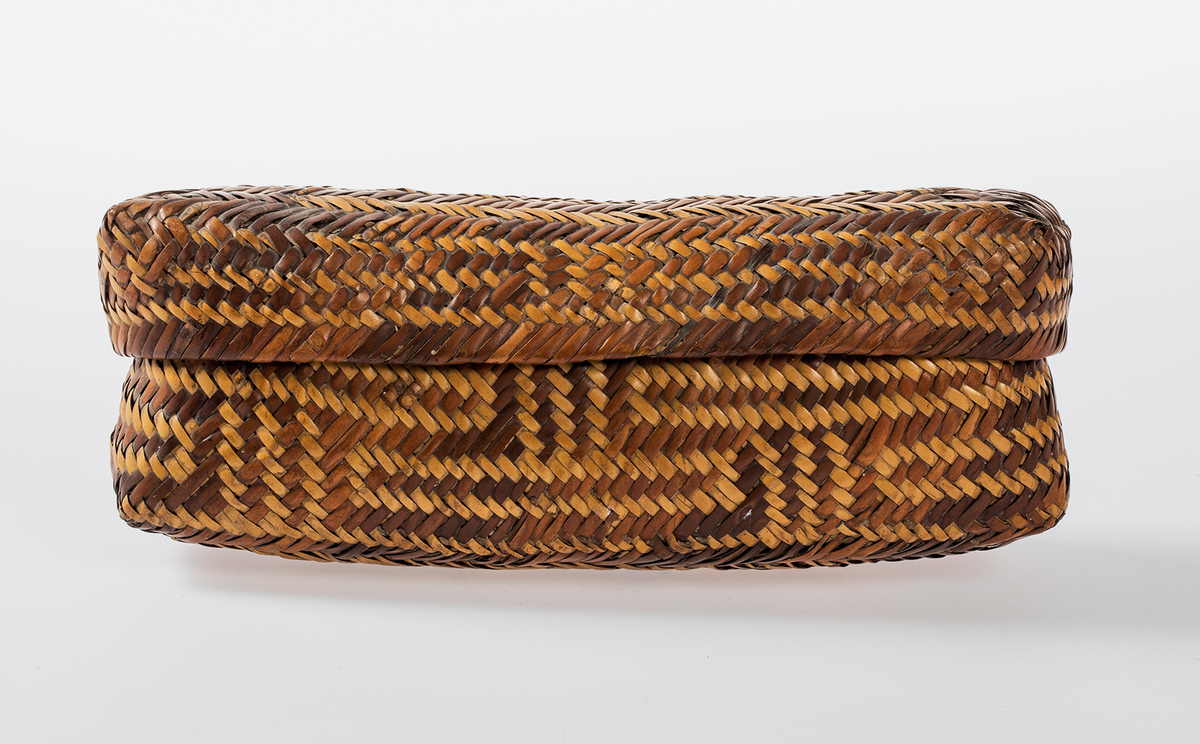
Figure 10 Once-known maker, basket with lid, southeastern United States, c. 1719–31. Rivercane and pigments, L. 9 in. Historiska Museet, Lund University, Sweden, LUHM 51
This double woven rivercane lidded basket was collected secondhand by Samuel Hesselius between 1719 and 1731. Originally listed as a box made from roots by Hesselius and later cataloged as Chinese in the Lund History Museum for three hundred years, the basket is currently cataloged as Chickasaw.
Hesselius described the basket in his 1736 catalogue as “No 9: A box which the American heathens have made from tree roots.” This suggests that Hesselius did not understand the materials he was collecting or the people who made them, and he likely purchased or was gifted this basket by a colonist or possibly an Indian Trader traveling to Philadelphia, where Hesselius had a home. By 1753 and until 2018, this basket was catalogued and displayed at Lund as Chinese.41 Curators at the museum have argued that a Cherokee attribution to the basket is problematic on the basis that naturalists such as Catesby and colonists like James Adair, writing fifty years after these baskets were collected, noted that other southeastern Native groups, including the Choctaw and Chickasaw, also made double woven rivercane baskets.42 The curators also pointed to Sloane’s use of the term “Carolina Basket” as opposed to a Cherokee basket.43 These are worthwhile observations, and it is impossible to definitively attribute these baskets to one cultural group or maker.
However, a 1724 copy of the deerskin map presented to Governor Nicholson in 1721 helps to show why a Cherokee attribution for the rivercane basket in the Lund collections is likely (fig. 12). The map shows the trade routes and relationships linking the Catawba Confederacy, the Cherokee, the Chickasaw, and the colonies of Virginia and South Carolina. Charleston had a direct link with the Cherokee that bypassed the Catawba towns. Virginia had limited connections with the Catawba through the English Road, and South Carolina made many efforts to regulate the Indian Trade coming from Virginia.44 The map clearly shows from an Indigenous perspective that Anglo-Chickasaw trade was mediated through trade with the Cherokee. While it is true that both groups produced double woven rivercane baskets, it is more likely that the basket Hesselius collected in the 1720s was of Cherokee design. Other entries in Hesselius’s 1736 catalogue shed more light on his secondhand collecting practices and suggest that he engaged with sailors and traders employed in the Indian Trade while they docked at Wilmington and Philadelphia.45

Figure 12 Francis Nicholson, “Map of the several nations of Indians to the Northwest of South Carolina,” 1724. Ink and pigments on deerskin, 31 × 46 in. Library of Congress, Washington, DC, Geography and Map Division, G3860 1724 .M2 1929
This copy of the original 1721 deerskin map shows the Cherokee near the upper right leg of the deerskin and connected to Charleston with a direct path. Here the Cherokee are the only direct connection between the English colonists and the Chickasaw, located at the far right.
They make the handsomest clothes baskets, I ever saw, considering their materials. They divide large swamp canes, into long, thin, narrow splinters, which they dye of several colours, and manage the workmanship so well, that both the inside and outside are covered with a beautiful variety of pleasing figures; and, though for the space of two inches below the upper edge of each basket, it is worked into one, through the other parts they are worked asunder, as if they were two joined a-top by some strong cement. A large nest consists of eight or ten baskets, contained within each other. Their dimensions are different, but they usually make the outside basket about a foot deep, a foot and an half broad, and almost a yard long.
The Indians, by reason of our supplying them so cheap with every sort of goods, have forgotten the chief part of their ancient mechanical skill, so as not to be well able now, at least for some years, to live independent of us. Formerly, those baskets which the Cheerake [Cherokee] made, were so highly esteemed even in South Carolina, the politest of our colonies, for domestic usefulness, beauty, and skilful variety, that a large nest of them cost upwards of a moidore.46
It is clear from Adair’s description that the makers associated with these double woven rivercane baskets were Cherokee.
During the second half of the eighteenth century, relationships between the British and Cherokee developed and formalized into an important economic and military alliance that forever changed Cherokee culture and politics, bringing the group fully into the sphere of global economy and politics. From the 1720s through the 1760s, Cherokee people fought the French, the Spanish, and their Native allies on behalf of their British trading partners. Double woven rivercane baskets continued to be associated with presentation and gift giving between Native and European allies.47 A letter from Captain Paul Demere, commander at Fort Loudon, to South Carolina Governor William Henry Lyttleton (1724–1808), dated May 1759, noted that he
This letter was sent just before things would change forever, yet again.
In the 1760s, broken promises, trade disputes, and Europeans squatting on land that had been affirmed to the Cherokee in treaties caused the Cherokee to wage war against their former British allies. Yet they would again ally with the British during the Revolutionary War. Such tumultuous events of the late eighteenth century caused political factions to form among the Cherokee that led to a civil war (1776–94) over the tribe’s future.
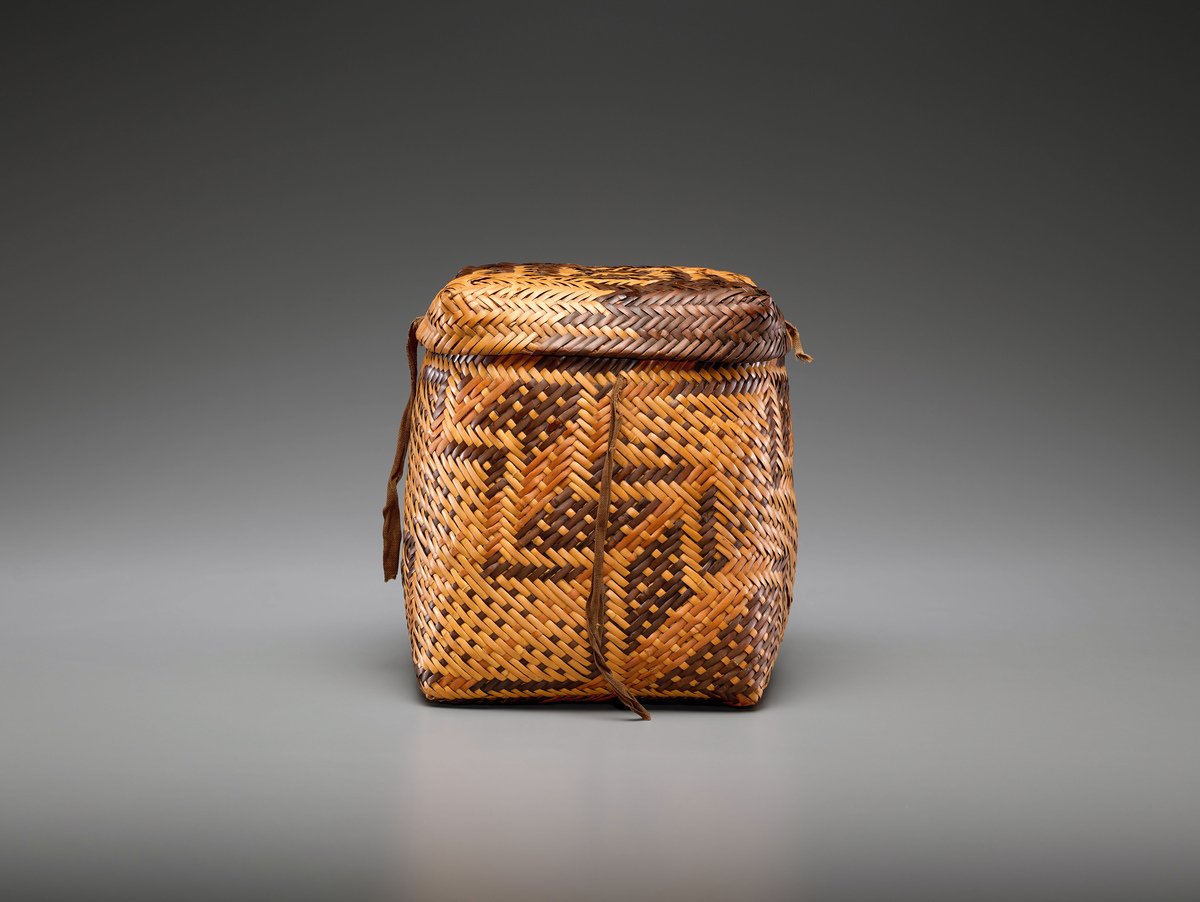
Figure 13 Once-known maker, basket with lid, Cherokee Nation, c. 1805–21. Rivercane, pigments, and leather. H. 9 in. Courtesy of the Yale Peabody Museum, YPM ANT 146789
This basket and the example in fig. 14 are part of a set of four donated to the Yale Peabody Museum of Natural History in 1955 by the Moravian Historical Society in Bethlehem, Pennsylvania. They were collected at the Moravian Springplace Mission, which operated on land belonging to the Vann family in the Cherokee Nation in present-day northwest Georgia. The baskets were likely collected between 1805 and 1821 from Peggy Scott Vann Crutchfield, the first Cherokee Moravian convert, by Anna Rosina Kliest Gambold (1762–1821). Crutchfield gave the baskets “as a remembrance,” and Gambold sent them as a gift to Moravian supporters of the mission.
A group of eight hundred to a thousand Cherokee remained in their homes in the isolated mountainous region of western North Carolina. The reasons that they were allowed to stay are shrouded in legend, but it is likely that they were distant enough from the goldfields of north Georgia to be left alone by white gold prospectors and land surveyors. EBCI land was mountainous, isolated, and undesired. As a result, they were isolated enough to ensure an enduring Cherokee presence in their homeland. The group also benefited from William Holland Thomas, a white merchant, lawyer, and adopted Cherokee, who purchased property in the tribe’s name and protected its collective land interests and rights. This complex relationship of state and federal tribal recognition and land trust saw the EBCI recognized by the US Government in 1868, the Qualla Boundary land trust recognized in 1876, and the tribe incorporated as the EBCI in 1889.53
Two nineteenth-century baskets in the collection of the Smithsonian’s National Museum of the American Indian epitomize the unbroken continuity of these basket forms and the legacies of their Cherokee makers (figs. 15, 16). From 1908–10, George Gustav Heye, founder of the Museum of the American Indian in New York City, sponsored anthropologist and archaeologist Mark Raymond Harrington to visit Native peoples in the American southwest and southeast. Harrington, a student of Franz Boas, purchased these baskets on this trip, keeping detailed records of these exchanges and recording names of the objects and owners in their Indigenous languages.54 These double woven medicine baskets, both of which have lids secured with textile fragments, were collected in 1908 and 1910. Harrington purchased the former for $0.50 on the Qualla Boundary from EBCI member Nancy Goingsnake, and he bought the latter for an unknown price from a Munsee Delaware man named Simon Hill. Harrington was aided in the purchase of the second basket by fellow Native material culture collector Peoria Chief William M. Skye.55 These objects speak to the enduring appeal of these baskets and the lengthy history of their collection. Such double woven rivercane baskets have been a constant in Cherokee culture as utilitarian or ceremonial items, colonial or early American trade goods, or as souvenirs for vacationers in the southern mountains.56 Cherokee makers have continued to make such double woven rivercane baskets through the traumas of colonization, displacement, cultural genocide, and modern tourism. For over three hundred years, the Cherokee double woven rivercane basket has remained a marker of strength, perseverance, and relationships to place.
Acknowledgments
About the Author
1 James Adair, The History of the American Indians (London: Edward and Charles Dilly, 1775), 423. While this article features and discusses a number of men due to the extant source material, it is focused on the art and work of Indigenous women. Beginning and centering the article with that in mind is important. We may not know the names of the Native women who wove all of these baskets, but their work, industry, and legacies live on in these works and through the continuity of the craft among contemporary Indigenous basketmakers of the American Southeast.
2 Rivercane, ᎢᎯᏯ/Ihiya (Arundinaria gigantea), is a bamboo-like grass that is found in central and southeastern North America. The plant flourishes in slow-moving rivers and grows in dense clusters known as canebrakes.
3 The Chitimacha Nation of present-day Louisiana is also well known for its own double woven rivercane lidded baskets and containers, a type that is made by almost all southeastern Native peoples. Mississippian pottery shows imprint decorations made by twill-woven cane baskets. The Museum of the Cherokee People in Cherokee, North Carolina, possesses an archaeological fragment of a double woven basket from before European contact. Similar styles of double woven reed and bamboo basketry can also be found in the southern Caribbean and along the northeastern coast of South America.
4 More research is needed to better understand the connections between the University of Pennsylvania, Hunter, and the craft education programs at the Cherokee School. An examination of Gertrude Flanagan’s papers may prove fruitful as she was the driving force behind Stamper’s interest in learning double weave techniques. Bonita Freeman-Witthof, “Cherokee Indian Craftswomen and the Economy of Basketry,” Expedition Magazine 19, no. 3 (May 1977), https://www.penn.museum/sites/expedition/cherokee-indian-craftswomen-and-the-economy-of-basketry/; Edward Dupuy and Clifford Hotchkiss, interview with Lottie Stamper, basket maker, January 14, 1965, Southern Highland Craft Guild Archives, Asheville, NC, SHCG_Mem28_Stam_1_a, https://southernappalachiandigitalcollections.org/browse/search/interview-with-lottie-stamper-basket-maker/search/keyword:lottie-stamper-32037/search-object/interview-with-lottie-stamper-basket-maker-14419; Helen Virginia Hunter, 1940. “The Ethnography of Salt in Aboriginal North America.” (master’s thesis, University of Pennsylvania).
5 Sarah H. Hill, Weaving New Worlds: Southeastern Cherokee Women and Their Basketry (Chapel Hill: University of North Carolina Press, 1997), 299–300; Susan C. Power, Art of the Cherokee: Prehistory to the Present (Athens: University of Georgia Press, 2007), 137–39; M. Anna Fariello, Cherokee Basketry From the Hands of Our Elders (Charleston, SC: History Press, 2009), 40–43.
6 Today, the mid-century double woven rivercane baskets made by students of Stamper, such as Eva Wolfe and Rowena Bradley, are highly collectible and sell for thousands of dollars at auction. New basketry work by EBCI artists, sold through Qualla Arts and Crafts Mutual (est. 1946), start at hundreds of dollars for a small example. Hill, Weaving New Worlds, 300–313; Power, Art of the Cherokee, 137–43; Fariello, Cherokee Basketry, 43–50. For more on federal policies toward Native art and crafts in the 1930s and 1940s, see Jennifer McLerran, A New Deal for Native Art: Indian Arts and Federal Policy, 1933–1943 (Tucson: University of Arizona Press, 2009).
7 Rebecca Toineeta was not the only EBCI elder to produce double woven rivercane baskets. Ayasta, Nancy George Bradley (Tahtahyeh), and Arizona “Zona” Swaney Blankenship were all weaving double woven rivercane baskets on the Qualla Boundary at the turn of the twentieth century. Bradley is part of a multigenerational dynasty of basket weavers. Fariello, Cherokee Basketry, 95, 97, 106–12, 122–25; Hill, 167–9, 198–212. For more on the early history of Native arts, cultural preservation, and histories of collecting, see Elizabeth Hutchinson, The Indian Craze: Primitivism, Modernism, and Transculturation in American Art, 1890–1915 (Durham, NC: Duke University, 2009).
8 Hill, Weaving New Worlds, 297–99; Fariello, Cherokee Basketry, 40–50.
9 For more on tourism and the EBCI, see Christina Taylor Beard-Moose, Public Indians, Private Cherokees: Tourism and Tradition on Tribal Ground (Tuscaloosa: University of Alabama Press, 2009); Christopher Arris Oakley, New South Indians: Tribal Economics and the Eastern Band of the Cherokee in the Twentieth Century (Knoxville: University of Tennessee Press, 2018); and C. Brenden Martin, Tourism in the Mountain South: A Double-Edged Sword (Knoxville: University of Tennessee Press, 2007).
10 Fariello, Cherokee Basketry, 36; Hill, Weaving New Worlds, 291.
11 Fariello, Cherokee Basketry, 43–50; Hill, Weaving New Worlds, 304–20.
12 The terminology of “once-known maker” appears within this essay to acknowledge that Western collectors of Indigenous North American objects rarely recorded the names of artists or makers, one of many forms of the historic erasure of Indigenous voices. Americana Insights is committed to adhering to Indigenous preferences in the research and presentation of their cultural identity and history.
13 Chakrabarti Pratik, “Sloane’s Travels: A Colonial History of Gentlemanly Science,” in From Books to Bezoars: Sir Hans Sloane and His Collections, ed. Alison Walker, Arthur MacGregor, and Michael Hunter (London: British Library, 2012), 71–79; James Delbourgo, Collecting the World: The Life and Curiosity of Hans Sloane (London: Allen Lane, 2017).
14 Sarah Hill and Anna Fariello, leading scholars on Cherokee baskets, both acknowledge the existence of a colonial basket trade when referencing the basket in the British Museum, but neither dive deeply into the subject as their work has been focused on contemporary Cherokee basket-weaving culture. For more on the effects of empire in southeastern North America, see Jessica Yirush Stern, ed., The Lives in Objects: Native Americans, British Colonists, and Cultures of Labor of Exchange in the Southeast (Chapel Hill: University of North Carolina Press, 2017); Michelle LeMaster, Brothers Born of One Mother: British-Native American Relations in the Colonial Southeast (Charlottesville: University of Virginia Press, 2012); and Matthew Mulcahy, Hubs of Empire: The Southeastern Lowcountry and British Caribbean (Baltimore: Johns Hopkins University Press, 2014).
15 Sir Hans Sloane, “Miscellanies, Antiquities, Seals, Pictures, Mathematical Instruments, Agate Handles, Agate Cups, Bottles, Spoons,” c. 1692–1710, Anthropology Library and Research Centre, Department of Africa, Oceania and the Americas, The British Museum (London), [EPF108491], https://enlightenmentarchitectures.reconstructingsloane.org/cataloguemiscellanies/#doc=1&page=EPF108491002.
16 Francis Nicholson (1655–1728) was a British colonial official who served in several administrative positions related to expanding the British Empire in North America and centralizing royal authority over the colonies. In this capacity, Nicholson served as the twenty-first governor of South Carolina from 1721 to 1725, during the years Catesby and Sloane were actively collecting in the region. Hill, Weaving New Worlds, 57–59; David I. Bushnell, “The Sloane Collection in the British Museum,” American Anthropologist 8, no. 4 (1906), 678–79; Mark Catesby to Hans Sloane, March 12, 1723/24, letter 3014, British Library, London, Sloane MS 4047, f. 147, The Sloane Letters Project, https://sloaneletters.com/letters/letter-3014.
17 For more on Sloane’s catalogs, see Marjorie Caygill, “Sloane’s Catalogs and the Arrangement of His Collections,” in From Books to Bezoars: Sir Hans Sloane and His Collections, ed. Alison Walker, Arthur MacGregor, and Michael Hunter (London: British Library, 2012), 120-36.
18 Sloane, “Miscellanies,” Bushnell, “Sloane Collection,” 672–74, 678–79; Patrick Dean, Nature’s Messenger: Mark Catesby and His Adventures in a New World (New York: Pegasus, 2023), 5–11, 45–53, 74–87.
19 Dean, Nature’s Messenger, 5–11, 67–112; Mark Catesby, Natural History of Carolina, Florida and the Bahama Islands (London, 1729–47).
20 Catesby to Sloane, November 15, 1723, letter 3130, British Library, London, Sloane MS 4047, f. 290–93, The Sloane Letters Project, https://sloaneletters.com/letters/letter-3130/.
21 Catesby to Sloane, November 15, 1723, letter 2980, British Library, Sloane MS 4047, f. 90, The Sloane Letters Project, https://sloaneletters.com/letters/letter-2980/. In a letter dated March 12, 1723/24, Catesby reported that he was departing from Charlestown for Cherokee lands; Catesby to Hans Sloane, November 15, 1723, letter 3014, British Library, London, Sloane MS 4047, f. 147, The Sloane Letters Project, https://sloaneletters.com/letters/letter-3014/.
22 Bushnell, “Sloane Collection,” 671–72.
23 Stern, Lives in Objects, 45–92. For more information on the deerskin trade in southeastern North America, see Alan Gallay, The Indian Slave Trade: The Rise of English Empire in the American South, 1670–1717 (New Haven, CT: Yale University Press, 2002).
24 Stern, Lives in Objects, 1–16; Gallay, Indian Slave Trade, 1–20, 70–98; Theda Perdue, Slavery and the Evolution of Cherokee Society, 1540–1866 (Knoxville: University of Tennessee Press, 1979).
25 John Lawson, The History of Carolina (London: William Taylor, 1714), 189.
26 His book was so popular and influential that an amended version appeared in Dr. John Brickell’s The Natural History of North Carolina (1743). To Lawson’s description of the cane baskets, quoted above, he added, “they sell these to the Planters when they come down amongst them to dispose of their Deer-Skins, Furs, and other Commodities.” This seems to suggest that the trade in Cherokee rivercane baskets had continued and expanded as relations with the Cherokee strengthened. John Brickell, The Natural History of North-Carolina with an account of the trade, manners, and customs of the Christian and Indian inhabitants (Dublin: printed by the author, 1743), 349.
27 Gallay, Indian Slave Trade, 259–87.
28 Paul Kelton, “Shattered and Infected: Epidemics and the Origins of the Yamasee War, 1696–1715,” in Mapping the Mississippian Shatter Zone: The Colonial Indian Slave Trade and Regional Instability in the American South, ed. Robbie Ethridge and Sheri M. Shuck-Hall (Lincoln: University of Nebraska Press, 2009), 312–32.
29 Mary Elizabeth Fitts and Charles L. Heath, “‘Indians Refusing to Carry Burdens’: Understanding the Success of Catawba Political, Military, and Settlement Strategies in Colonial Carolina,” in Ethridge and Shuck-Hall, Mapping the Mississippian Shatter Zone, 142–62.
30 Gallay, Indian Slave Trade, 199–222, 241–65; Matthew H. Jennings, “Violence in a Shattered World,” in Ethridge and Shuck-Hall, Mapping the Mississippian Shatter Zone, 272–94; Denise I. Bossy, “Godin & Co.: Charleston Merchants and the Indian Trade, 1674–1715,” South Carolina Historical Magazine 114, no. 2 (2013): 96–131.
31 W. L. McDowell, ed., “Colonial Records of South Carolina: Journals of the Commissioners of the Indian Trade, September 20, 1710–August 29, 1718” (Columbia: South Carolina Archives Department, 1955), South Carolina Digital Archives and History, pp. 120–21, https://scdah.sc.gov/journals-commissioners-indian-trade.
32 McDowell, 120–21.
33 McDowell, 120–21.
34 McDowell, 129.
35 This quote comes from a November 6, 1762, auction advertisement reproduced in a published version of McDowell’s “Colonial Records.” William L. McDowell Jr., ed., Colonial Records of South Carolina, Documents Relating to Indian Affairs, 1754–1765 (Columbia: South Carolina Archives Department, 1970), South Carolina Department of Archives and History, https://scdah.sc.gov/documents-relating-indian-affairs-1754-1760, 518. Thomas Lamboll, Thomas Shubrick, and John Savage were listed as directors for the Board of Trade charged with administering the vendue.
36 McDowell, Colonial Records, 149–50.
37 McDowell, 149–50.
38 Wilma A. Dunaway, “The Southern Fur Trade and the Incorporation of Southern Appalachia into the World-Economy, 1690–1763.” Review (Fernand Braudel Center) 17, no. 2 (1994): 215–42; Bossy, “Godin & Co.,” 96–131.
39 Andreas Manhag and Hanna Wittrock, “In Search of New Sweden: Discovering the ‘American Curiosities’ of Samuel Hesselius,” Journal of the History of Collections 31, no. 2 (2018): 239–43, https://doi.org/10.1093/jhc/fhy028; Kenneth A. Lockridge, “Overcoming Nausea: The Brothers Hesselius and the Great American Mystery,” in English Atlantics Revisited: Essays Honouring Professor Ian K. Steele, ed. Nancy L. Rhoden (Montreal: McGill-Queen’s University Press, 2007), 390–93.
40 Manhag and Wittrock, “In Search of New Sweden,” 239–41.
41 Manhag and Wittrock, 245.
42 James Adair, an Anglo-Irish colonist and historian, lived with the Chickasaw and other Native southeastern groups beginning in 1735, nearly ten years after the baskets in the Lund and British Museums were collected. In his History of the American Indians, Adair noted that “formerly the Indians made very handsome carpets” from wild hemp. This craft was already being lost due to the trade in manufactured cotton and woolen textiles (p. 422).
43 Adair, 245–46.
44 Ian Chambers, “A Cherokee Origin for the ‘Catawba’ Deerskin Map (c. 1721),” Imago Mundi 65, no. 2 (2013): 209–14, https://doi.org/10.1080/03085694.2013.784564.
45 Item 14 in his collection was described as an “Indian Idol, which they carry around their necks and worship, which could never have been acquired from them, had not an Englishman found it in the forest on a dead Indian.” The idol, like the basket, was miscatalogued as Chinese for centuries. The female anthropomorphic figure appears to be made of ivory bone, and the curators of the Lund Museum were able to estimate that it may have come from the Pacific Northwestern coast of North America, which, if true, would be incredibly early. More research on the Hesselius collection is needed. Manhag and Wittrock, “In Search of New Sweden,” 243–44.
46 A moidore was a Portuguese gold coin used in the eighteenth-century British colonial world. Its value was equivalent to twenty-eight shillings. Adair, History of the American Indians, 424.
47 Stern, Lives in Objects, 93–121; Kristofer Ray, “Cherokees and Franco-British Confrontation in the Tennessee Corridor, 1730–1760,” Native South (Lincoln, NE) 7, no. 1 (2014): 33–67, https://doi.org/10.1353/nso.2014.0004.
48 McDowell, Colonial Records, 484–45.
49 Jamie Myers Mize, “‘To Conclude on a General Union’: Masculinity, the Chickamauga, and Pan-Indian Alliances in the Revolutionary Era,” Ethnohistory 68, no. 3 (2021): 429–48, https://doi.org/10.1215/00141801-8940515; Jennifer Elliott, “Ga-Ne-Tli-Yv-s-Di (Change) in the Cherokee Nation: The Vann and Ridge Houses in Northwest Georgia,” Buildings & Landscapes 18, no. 1 (2011): 43–63, https://doi.org/10.1353/bdl.2011.0011.
50 Andrew Denson, Monuments of Absence: Cherokee Removal and the Contest Over Southern Memory (Chapel Hill: University of North Carolina Press) 19–23.
51 Sarah H. Hill, “Weaving History: Cherokee Baskets from the Springplace Mission,” William and Mary Quarterly 53, no. 1 (1996): 115–36, https://doi.org/10.2307/2946826.
52 Andrew Denson, Monuments of Absence, 18–52.
53 Oakley, New South Indians, 2–49.
54 Hill, “Weaving History,” 170–81, 212–14. Harrington purchased seventy-one objects for $75. Twenty-one of the objects were baskets, which cost Harrington between $.05 and $1.25 each (pp. 251–52).
55 It should be noted that although Harrington purchased these baskets. The power dynamics meant that fair market values and ethical exchanges were nearly impossible. While in western North Carolina, Harrington had excavated Cherokee burial mounds, desecrated and looted burials, and collected objects without permission from the EBCI in an effort to preserve what ethnologists believed to be a dying Native culture. In reality such beliefs were used to justify cultural violence. See Hill, “Weaving History,” 47, 51–54; M. R. Harrington, “Cherokee and Earlier Remains on Upper Tennessee River,” Indian Notes and Monographs (New York: Heye Foundation, 1922), 240–43; M. R. Harrington, “Vestiges of Material Culture among the Canadian Delawares,” American Anthropologist 10, no. 3 (1908): 408–18, https://doi.org/10.1525/aa.1908.10.3.02a00040; J. Alden Mason, “George G. Heye, 1874–1957,” Leaflets of the Museum of the American Indian, no. 6 (New York: Heye Foundation, 1958), 7–17.
56 Hill, “Weaving History,” 55–60.

